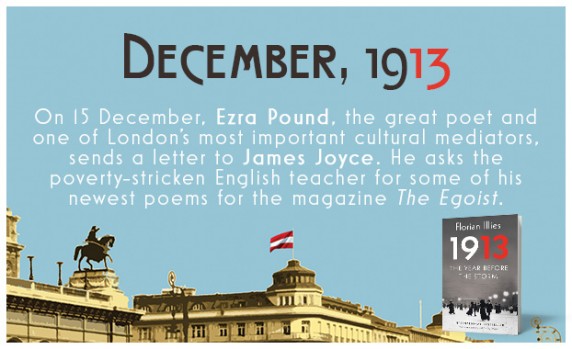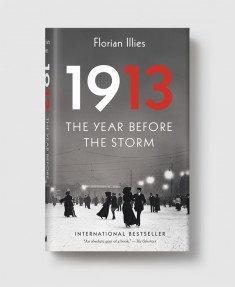December 20, 2013
The end of 1913: Rilke wants peace, the Mona Lisa crosses the French border, and Kafka writes a very long (and somewhat creepy) love letter
by Melville House

It was the year Henry Ford first put a conveyer belt in his car factory, and the year Louis Armstrong first picked up a trumpet. It was the year Charlie Chaplin signed his first movie contract, and Coco Chanel and Prada opened their first dress shops. It was the year Proust began his opus, Stravinsky wrote The Rite of Spring, and the first Armory Show in New York introduced the world to Picasso and the world of abstract art. It was the year the recreational drug now known as ecstasy was invented.
It was 1913, the year before the world plunged into the catastrophic darkness of World War I.
December 30, 1913-January 1, 1914
Date unknown: Rainer Maria Rilke is in a bad way during those last December days in Paris. He writes: “I see nobody, it has been freezing, there was black ice, it’s raining, it’s dripping—this is winter, always three days of each. I have truly had my fill of Paris, it is a place of damnation.” And then: “Here is the incarnation of my desires for 1914, 1915, 1916, 1917 etc. Which is: peace, and to be in the country with a sisterly person.” He then writes to one of those sisterly people, although her thoughts are elsewhere right now: Sidonie Nádherny: “Now I would like to be as if without a face, a rolled-up hedgehog that only opens up in the ditch in the evening and cautiously comes up and holds its grey snout up at the stars.”
At the end of 1913 a surprising book is published. Its name is The Year 1913—in it is the attempt to give an account of the present, which is “rich in cultural values” but which at the same time sees an “increased blunting and superficiality in the masses.” The chief highlight is the last essay by Ernst Troeltsch about the religious phenomena of the present: “It is the old story that we all know, which for a while we called progress, and then decadence, and in which people now like to see the preparation of a new idealism. Social reformers, philosophers, theologians, businessmen, psychologists, historians signal it. But it is not there.”
December 31: Late in the evening of 31 December the Mona Lisa crossed the French border.
Käthe Kollwitz, weary of life with her husband and uncertain about which direction her art should take, acknowledges: “At any rate 1913 has passed quite innocuously, not dead and sleepy, quite a lot of inner life.”
New Year’s Eve 1913. Oswald Spencer writes in his diary: “Life in this century oppresses me. Everything redolent of comfort, of beauty, of colour, is being plundered.”
January 1: Felice Bauer is no longer returning Kafka’s letters. They speak briefly on the phone: Felice begs him not to come to Berlin for Christmas and promises she will write to him soon. But she doesn’t. When there is still no sign of a letter by midday on 29 November, Franz Kafka sits down in Prague and starts a new letter, his second proposal. He writes and broods, writes and broods. By New Year’s Eve he has reached page 22. By the time he finishes, the letter is thirty-five pages long. Kafka writes: “Felice, I love you with all that is humanly good in me, with everything that makes me worthy of being among the living.” When the bells of Hradčany ring out at midnight, Kafka stands up briefly and goes over to the window. The family moved in November, so Kafka is no longer looking out over the river and the bridge and the parks, but is looking at the Altstadtring. It’s snowing softly and unrelentingly, muffling the cannon shots from the castle, and outside in the streets people are celebrating the arrival of a New Year. Kafka sits back down and continues to write: “Even the fact that there are things in me you find fault with and would like to change, I love that too, I just want you to know that.”
